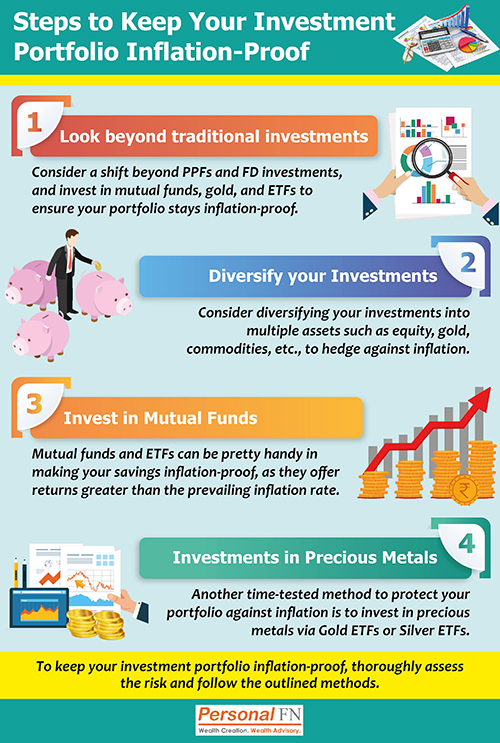Steps to Keep Your Investment Portfolio Inflation-Proof
Mitali Dhoke
May 06, 2022
Listen to Steps to Keep Your Investment Portfolio Inflation-Proof
00:00
00:00

Our savings are constantly affected by forces beyond our control. The recent global events, the Russian-Ukraine war, and the resurgence of COVID-19 prove that inflation is an uninvited guest who is here to stay. These foreign events have had a significant influence on long-term investments and our savings, as well as raising the average cost of living in India.
Inflation is defined in simple words as too much money chasing too little things. To put it differently, a rupee today will not buy the same amount of products five years from now. Inflation is defined as the average price level of a basket of goods and services in an economy over a specified time period. Inflation arises for a variety of causes. Supply shocks caused by the pandemic, which affects production, high oil prices, and increases in production costs are all potential factors for India's recent hike in the inflation rate.
Surging inflation is expected to be a serious bottleneck for India's economy. Rising prices are a major concern for everyone ranging from government, companies, consumers, and investors. In India, the inflation rate started going up in September 2021, when it was 4.35%, reaching an all-time high at 6.01% in January 2022. In the month of March 2022, Indian retail inflation soared to 6.95% crossing the upper limit of 6% set by the RBI for the FY 2022-23.
Most investors feel that inflation will be a key barrier for markets in 2022, and they are concerned about how their assets will be affected. For investors, beating inflation appears to be an intractable challenge. There are, however, ways to shield your hard-earned money from the harmful consequences of inflation. Inflation does not have a negative impact on all assets. All you have to do now is figure out how to reduce the impact of inflation on your investments.
To stay ahead of inflation, look at your investment mix as a whole and evaluate where you stand. There are no silver bullets, you may need a combination of investments to provide a potential return that can keep up with the effects of rising prices. Include some worthy investments that could be better at generating inflation-beating returns than the existing ones in your portfolio.
Thus, while we all know what inflation is, the real question is where you should invest your money to shield it from the invasive effects of inflation on your portfolio.
 (Image Source: www.freepik.com)
(Image Source: www.freepik.com)
Join Now: PersonalFN is now on Telegram. Join FREE Today to get ‘Daily Wealth Letter’ and Exclusive Updates on Mutual Funds
Here are some steps to follow to keep your investment portfolio inflation-proof:
1. Look beyond traditional investments
Indians still prefer holding a major part of their portfolio in traditional investments like Fixed deposits and Sovereign-rated government-backed products, etc. In the last couple of years, Indian investors have had to face what they have never experienced before. Fixed deposit rates have been falling over the last couple of years and are at an all-time low.
Given that, it's prudent for investors to consider a shift beyond PPFs and FD investments, and to ensure long-term financial stability and security, you need to send your money to work. Savings through PPF and FDs are safe but are they enough to beat inflation?
As per Historical data, FDs are not a way to generate wealth, and neither do they protect the average investor from inflation. The sad truth is that if your interest rate is less than the average inflation rate in the country, then your purchasing power will be compromised, and your investments are likely to get wasted. Beating inflation requires looking beyond PPFs and FDs as investment options; you need to invest in stocks, mutual funds, real estate, gold, and exchange-traded funds (ETFs) to ensure your portfolio stays inflation-proof and your investments provide a hedge against rising inflation.
2. Consider diversifying into multiple asset-classes
Diversification is the key to hedge against inflation, investors can consider investing in asset classes that tend to outperform the market during inflationary climates. With any diversified portfolio, keeping inflation-hedged asset classes on your watch list and then striking when you see inflation can help your portfolio thrive when inflation hits.
Common anti-inflation assets include equity, gold, commodities, various real estate investments, TIPS, etc. There are several asset classes to invest in when aiming to protect your investment portfolio against inflation. Do note these alternative asset classes are not suitable for everyone, and one should invest purely based on their risk profile and investment goals.
Increasing international exposure can also be a helpful way to protect against inflation. There are a number of large economies throughout the world that behave differently, and investing in developed markets with low correlations to domestic inflation may yield greater risk-adjusted returns. Adding international investments to your portfolio might help protect your portfolio from domestic economic fluctuations. ETFs and Mutual funds are two of the most straightforward ways to diversify investments in international markets. When compared to investing directly in global markets, these funds provide a low-cost option.
Notably, retirees with a very conservative investment mix may be exposed to higher inflation risk. By adding inflation-resistant investments to your portfolio and diversifying across asset classes, you may be able to reduce this risk.

3. Invest in Mutual funds
Mutual funds and ETFs can be pretty handy in making your savings inflation-proof, as they offer returns greater than the prevailing inflation rate. While it is empirically evident that in an inflationary trend, bond returns are not attractive, the association between inflation and equity returns is mixed.
Equities offer a buffer against inflation; this is because a rise in prices should correspond to a rise in nominal revenues and thus boost share prices. Equities tend to do well in inflationary environments because corporate earnings are also strong; investing in equity using a combination of active and passive funds can help hedge against inflation. Equity mutual funds can potentially offer substantial returns on your initial investment. These are driven by the principle of compounding and can easily add increasing value to your invested sum.
However, they can be volatile and offer greater risks. Mutual funds and ETFs are viable options of investing available to new investors and allow you to invest in lump sums or through an SIP and are Highly liquid in nature. This equity exposure in your portfolio should not be through Adhoc investing in stocks or a basket of stocks but with a combination of simple active and passive mutual funds.
With stocks, investors find it difficult to choose the right stocks and decide when to exit. Choosing suitable and worthy mutual funds and remaining invested with a long-term approach needs to be the motto. Try to be mindful of your investments, if you are just starting off, then don't hesitate to seek out professional help.
4. Investment in precious metals
Another time-tested method of protecting your portfolio against inflation is to invest in precious metals such as gold and silver. Historically, these assets have shown a high degree of resiliency during prolonged periods of inflation. Investing in precious metals can also help diversify your portfolio if it's comprised mostly of stocks and bonds.
Gold has traditionally been a safe-haven asset for investors when inflation revs up, or interest rates are very low. Gold, historically, has been a beloved investment option for Indians. The yellow metal has constantly seen an increase in value during trying times, and the price of gold rose during COVID-19, making it the perfect investment asset.
Silver, again another precious metal, has a lot of industrial value (apart from jewellery usage) as it is an important component in electronics and emerging technology products. As far as investors are concerned, instead of buying gold in physical form, one can buy gold and silver Exchange-traded funds (ETFs), sovereign gold bonds, Gold saving funds, etc.
However, Precious metal investments have a major drawback, they do not yield any income. When interest rates rise, which often happens during periods of inflation to combat the effects, precious metals can significantly underperform financial securities.
Thus, a more sensible approach is establishing a strategic allocation of precious metals up to 5% to 10% in your portfolio. This modest allocation can provide a source of strength during inflationary periods and improve the overall efficiency of your portfolio.
To conclude...
Your investment decisions contribute in a big way to inflation-proofing your portfolio. Frequent churning, performance chasing, and exiting at the first sign of volatility lead to sub-optimal gains. To keep your investment portfolio inflation-proof, thoroughly assess the risk and follow the outlined methods.
Always keep in mind that your investment portfolio is built around your long-term objectives, risk tolerance, and time horizon. Avoid making impulsive investing decisions based on predicted short-term changes in the economy. Make sure any strategies you use to hedge against inflation align with your overall financial plan and help you meet your financial goals.
Therefore, it is essential to draw up worthy investment strategies and make an informed investment decision to create a robust investment portfolio that you would be able to beat the inflation or at least try to minimise its impact on your wealth creation.
PS: If you wish to select actively managed worthy mutual fund schemes, I recommend that you subscribe to PersonalFN's unbiased premium research service, FundSelect.
As a bonus, you get access to PersonalFN's popular debt mutual fund service, DebtSelect.
PersonalFN recommendations go through our stringent process that assesses both quantitative and qualitative parameters, providing you with Buy, Hold, and Sell recommendations on equity and debt mutual fund schemes. Read here for more details...
If you are serious about investing in rewarding mutual fund schemes, Subscribe now!
Warm Regards,
Mitali Dhoke
Jr. Research Analyst